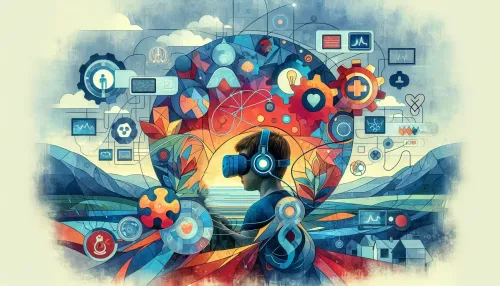Simplifying the World of Wearable Tech for Autistic Children

In today's digital age, wearable technology has revolutionized the way we interact with the world. From fitness trackers to smartwatches, wearable devices have become an integral part of our daily lives. However, the impact of wearable tech goes beyond convenience; it has proven to be a valuable resource in supporting autistic children, addressing their unique needs and enhancing their overall quality of life.
Autistic children often navigate a world that can be overwhelming due to sensory sensitivities, social communication challenges, and repetitive behaviors. Wearable tech has emerged as a promising aid in addressing these complexities. By providing personalized solutions that cater to the specific requirements of each child, these devices aim to simplify their daily experiences.
How Wearable Devices Support Autistic Children
Wearable devices for autistic children encompass a diverse range of technologies designed to assist in various aspects of their lives. These innovations include sensory-friendly clothing embedded with calming textures, smartwatches equipped with visual schedules and reminders, and sensory feedback devices that offer comfort during times of distress. The overarching goal is to mitigate anxiety, support communication, and promote independence in daily activities.
What are wearable devices for autistic children?
The integration of wearable technology into an autistic child's routine can significantly improve their ability to navigate daily activities. For instance, sensory-friendly clothing provides tactile comfort, reducing irritability and promoting a sense of ease. Similarly, visual schedules and reminders on smartwatches aid in fostering structure and predictability, easing transitions between tasks or environments.
Sensory sensitivities are a common challenge for autistic children. Wearable devices address this issue by incorporating features such as adjustable vibration patterns or gentle pressure stimulation, providing a calming sensation that mitigates sensory overload. These personalized comfort solutions contribute to creating a more manageable sensory environment for the child.
How do wearables improve daily routines?
While the concept of wearable technology may seem complex, the underlying mechanisms are designed to seamlessly integrate into a child's life. Whether through haptic feedback systems or user-friendly interfaces, these devices prioritize simplicity and functionality. The technology aims to be unobtrusive, ensuring that it complements the child's needs without overwhelming them with intricate details.
How do wearables address sensory sensitivities?
One of the key strengths of wearable tech is its ability to be customized according to each child's specific requirements. Whether it's adjusting the intensity of sensory feedback or personalizing visual cues on a device, these customizable features empower parents and caregivers to cater to their child's unique preferences. This individualized approach ensures that the wearable device effectively meets the child's needs.
Related Article: Wearable Tech Advancements: Empowering Autistic Children with Innovative Therapeutic Interventions
What technology powers wearable devices?
When selecting wearable technology for an autistic child, it is essential to consider factors such as their sensory profile, communication abilities, and daily routines. Consulting with professionals experienced in working with autistic individuals can offer valuable insights into identifying the most suitable devices. Additionally, exploring user reviews and testimonials can provide practical perspectives on the effectiveness of different wearable options.
As technology continues to advance, the future of wearable devices for autistic children holds promising prospects. Innovations focused on enhancing ease of use and expanding accessibility are expected to drive positive developments in this field. Moreover, ongoing efforts to make these technologies more affordable and widely available aim to ensure that all families have access to beneficial solutions for their children.
Customization of Wearable Tech for Individual Needs
Wearable tech not only serves practical functions but also facilitates opportunities for social interaction and skill development. Interactive game-based platforms and communication aids integrated into wearables encourage engagement with peers and family members. By utilizing technology as a medium for social connection, these devices foster meaningful interactions and support the development of vital social skills.
How to choose the right wearable for your child?
HorizonsMind understands the importance of empowering families with resources that simplify and enhance the lives of autistic children. As wearable technology continues to evolve and redefine possibilities, it offers invaluable support in addressing the unique needs of individuals on the autism spectrum. By embracing these innovative solutions, families can provide holistic care tailored to their child's requirements, fostering independence, comfort, and enriching experiences.
Frequently Asked Questions
Wearable devices for autistic children include sensory-friendly clothing, smartwatches with visual schedules, and sensory feedback devices. These technologies aim to support communication, reduce anxiety, and promote independence by catering to the unique needs of each child.
Wearable technology addresses sensory sensitivities by incorporating features like adjustable vibrations or gentle pressure. These calming sensations help mitigate sensory overload, creating a more manageable environment for autistic children and enhancing their overall comfort during daily activities.
Yes, wearable technology can facilitate social interaction through interactive games and communication aids. By encouraging engagement with peers and family members, these devices help develop vital social skills and foster meaningful connections, enhancing the child's social experience.
Check Out These Related Articles

Embracing Virtual Therapies: Enhancing Autism Care in the Digital Age

Data-Driven Parenting: Leveraging Technology for Informed Decision-Making in Autism Care

The Revolution of Augmented Reality in Autism Education
